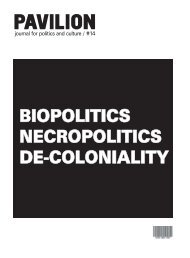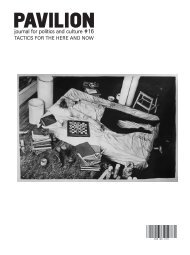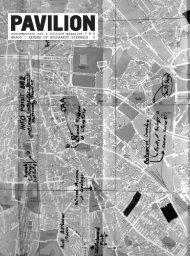PAVILION
PAVILION
PAVILION
- No tags were found...
You also want an ePaper? Increase the reach of your titles
YUMPU automatically turns print PDFs into web optimized ePapers that Google loves.
tage of a semicircular hall, by contrast, is<br />
that at least one person, the speaker, can<br />
see and hear everyone equally well.<br />
However, factions, contradictions and<br />
distances emerge more readily as a<br />
result. Moreover, any lengthening of the<br />
semicircle leads to the formation of blind<br />
spots from which it is impossible to see or<br />
be seen.<br />
If parliamentary architecture is to take<br />
account of democratic principles it must<br />
enable all the lawmakers to make themselves<br />
heard and understood and to communicate<br />
their views. The tension<br />
between the architecture, which prescribes<br />
a certain use and certain patterns<br />
of behavior, and the debates in a parliament<br />
bestows different powers on the<br />
parliamentary players. Anyone occupying<br />
the Speaker’s chair or a seat on the government<br />
benches or controlling what is<br />
going on behind the scenes obviously<br />
has more power than a backbencher. But<br />
it is not just the members of a parliament<br />
who have power. The architecture does,<br />
too. It determines not only how the members<br />
of the parliament can communicate<br />
with one another but also who speaks to<br />
whom and about what. It determines who<br />
sees and hears what. Moreover, it determines<br />
whose voice counts. In a circular<br />
chamber it is possible and sensible for<br />
everyone to speak from his or her seat.<br />
This makes it clear that a single opinion is<br />
being expressed and that just one of<br />
many possible viewpoints is being contributed<br />
to the overall picture. If there is a<br />
rostrum, however, the speaker addresses<br />
the audience in a semicircle, having no<br />
choice but to take up the sole legitimate<br />
speaking position.<br />
The wrestling over parliamentary architecture<br />
shows that the ability to speak<br />
and make decisions depends on the<br />
opportunity to participate, to be present,<br />
visible and audible. The existence of<br />
political conflicts, the admission of various<br />
persons (genders, generations), the<br />
lively debate, the audibility of many different<br />
voices, the articulation of approval or<br />
disapproval can be hindered or reinforced<br />
by architectural means.<br />
Ever since the French Revolution the<br />
hegemony of “representative democracy”<br />
has rested on the semicircular model of<br />
the classical Roman theater. The seating<br />
arrangements put the focus on the rostrum.<br />
According to the theory, it is performances<br />
in the form of monologues that<br />
gives shape and a voice to the people,<br />
who for their part subsequently express<br />
their will through their representatives.<br />
Wherever “representative democracy”<br />
has been introduced, it was not the result<br />
of a plebiscite but of a decree issued by a<br />
parliament, for which (on average) hundreds<br />
of members were needed. The<br />
number of representatives derives not<br />
from the size of the population or from the<br />
statistical average of the supposed political<br />
elite but quite simply from the number<br />
of seats in this type of theater.<br />
III.<br />
The key criterion of the political in traditional<br />
political philosophy would appear<br />
to be a decision based on rational consideration.<br />
This criterion could be met<br />
behind closed doors. Is not the holding of<br />
a debate pure sham? Why do we need a<br />
parliament? Why is the public space<br />
important for political decisions? Does<br />
the semicircle of members of a parlia-<br />
ment constitute a satisfactory audience?<br />
Is a television broadcast of the proceedings<br />
sufficient or is a public only properly<br />
established when it can articulate itself<br />
and voice criticism and when anyone who<br />
wishes can take part?<br />
In answering these questions it is important<br />
to distinguish between a public<br />
space that collects or interrupts and the<br />
political space that forms part of the<br />
social space. The social arises from<br />
spaces of ordered communication and<br />
presumes that an assembly exists. The<br />
political space uses aesthetic, disciplinary<br />
and biological means to put people<br />
in certain positions. It is characterized by<br />
conditions of control, by the markings of<br />
appropriation and by distancing mechanisms,<br />
which identify the subjects and<br />
stabilize them in the hierarchical<br />
(genealogical, and the like) relationships<br />
they have with each other (for example<br />
hospitals, schools, prisons, parliaments).<br />
In the political sphere power can therefore<br />
be exercised and reproduced,<br />
whereas the public space cannot be cordoned<br />
off and controlled. On the contrary,<br />
it is not subject to any unequivocal system<br />
of perception, permitting a wide<br />
range of insights, allowing anonymity and<br />
opening up channels of communication<br />
for new participants, new distributions<br />
and new questions.<br />
The public gallery is an alien element in<br />
the classical theatrical architecture in<br />
which the members of a parliament find<br />
themselves. Like a wedge, it pries open<br />
the closed nature of the parliamentary<br />
system of perception and participation.<br />
The penetration of the public into the<br />
political space can only be explained by<br />
the radical democratic currents of the<br />
French Revolution.<br />
Proceedings in the English Parliament<br />
once took place behind closed doors if for<br />
no other purpose than to pursue policies<br />
directed against the king and his court. “I<br />
spy strangers,” was the formal call for the<br />
doors of the House of Commons to be<br />
closed and for any potential listeners to<br />
be removed.<br />
From the point of view of enlightened<br />
analysis there is no reason why the journalistic<br />
debate should not relate exclusively<br />
to texts, for instance to announcements<br />
made by a parliament or government<br />
followed by discussion of them in<br />
specialist journals. Quite clearly, however,<br />
that is not a satisfactory situation for<br />
either the press or the public. Reports on<br />
parliamentary activities and daily events<br />
can reinforce or undermine the sovereignty<br />
of a parliament. The physical presence<br />
of watching journalists brings quite<br />
different forces into play. In 1798, for<br />
instance, the British secretary of war,<br />
William Windham, complained about the<br />
continual reporting and warned that press<br />
coverage of the parliamentary debates<br />
would inevitably transform the English<br />
constitution from a representative one<br />
into “an entirely democratic one”. And in<br />
1826 Wellington wrote: “Discussions with<br />
open doors, and the publication of the<br />
discussions of a Legislative Assembly,<br />
however desirable, are not absolutely<br />
necessary for the existence of freedom or<br />
good government in any country. Our<br />
own regulations, and the principles on<br />
which the discussions of our Houses of<br />
Parliament are founded and carried on,<br />
are that they are private and not to be<br />
made public.”<br />
But in what sense can discussions<br />
[178]<br />
[179]








